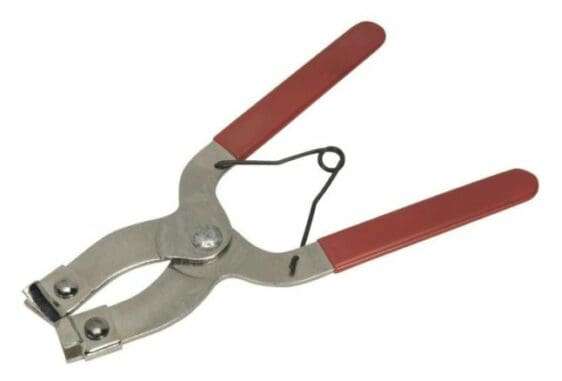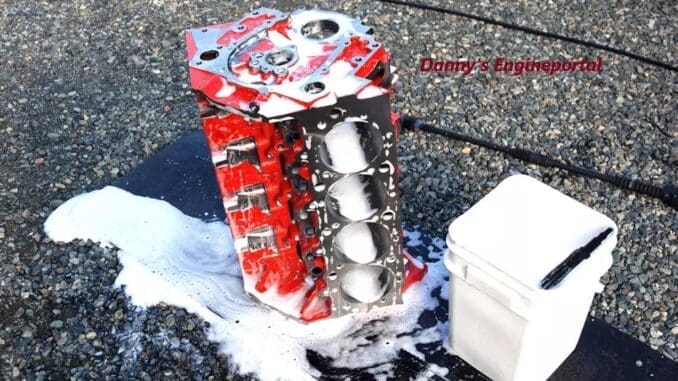
So, the first sign of worn out piston rings, is engine blow-by.
Consequently, if you are seeing puffs of blue smoke out of the exhaust, it means the engine is burning oil.
Also, with worn or damaged piston rings, you may notice that the engine oil gets low, faster than before. Consequently, blue oil smoke first appears, when you start your engine, while it is still cold.
But, as the engine warms up, the pistons and Piston Rings expand, and start to seal the cylinder walls. As a result, reducing how much oil, is blowing past the rings. Eventually, the piston rings wear to the point, that there is constant blow-by. So, the engine will have Blue Exhaust Smoke, all the time.

Another issue with blow-by is, combustion gases entering the crankcase. This means fuel and combustion by-products, are in the oil.
As these chemicals permeate the oil, the oil loses its viscosity, and the ability to cool and lubricate the engine. As a result, you must change the oil more often, to keep the engine clean. This is also a big factor in, bearing damage as well.
Eventually, the wear gets so bad that there is, a loss of power:
- Combustion gas, is getting into the crankcase.
- Too much oil, is getting into the combustion chamber.
This leads to fouled spark plugs, and a poorly running engine.
Typical Ring Configuration

Compression Rings or Pressure Rings
The compression rings provide sealing, above the piston and prevents, the gas leakage from the combustion side. Located in the top grooves, are the compression rings. However, this may differ, according the design of the engine. The main function of these rings is, to seal the combustion gases. And, transfer heat, from the piston to the cylinder walls.
Second or Intermediate Rings
The oil is controlled, by shearing the layer of the oil left by the oil ring. But, still providing the top compression rings enough lubrication. Moreover, it also provides help, to the top compression ring in sealing and heat transfer.
Oil Control / Scraper Rings
The oil control rings, controls the amount of lubricating oil, passing up or down the cylinder walls. Oil rings are also used, to spread the oil evenly around the circumference of the cylinder. These rings, do not allow oil to pass from, between the face of the ring and the cylinder.
Most engines today have very tight piston-to-wall clearances (.001 in. or less), to minimize blow-by and reduce piston rock. So, the more stable the piston, the better the rings can maintain a tight seal.
Close tolerances also make, for a quieter running engine, especially after a cold start, when clearances are greatest). Anti-scuff moly-based coatings, are used on the sides of many stock and performance pistons. Skirt coatings not only protect the pistons, but also allow for tighter clearances, between the piston and cylinder. As a result, this will reduce piston rocking and blow-by.
Checking Piston Rings End Gap
When measuring piston ring end gap, check the gap, in two different places. Both, at the top and the bottom of the cylinder bore. If the cylinder bore has taper, the end gap will be larger at the top, and smaller at the bottom.
Use the bottom position to set the end gap. Because, if you use the top of a worn bore to set the end gap, the end gap will be too small, when the piston reaches the bottom of the bore.

The ends of the ring may hit each other, causing the ring to bind and scuff. You should probably bore cylinders, that have more than .003 to .005 inches of taper. Always refer to the engine manufacturer’s specifications, for the maximum allowable taper wear. Also, another choice can be, file fit piston rings.
Installing Piston Rings
Installation is very important. One of the most common installation errors is, Installing one or more rings upside down.
Common installation errors:
- What if, one second oil ring is accidentally installed, upside down in a V8 engine. Consequently, it can double, the engine’s oil consumption!
- But, if every second ring on all the pistons are reversed. The engine will have, an unquenchable thirst for oil. And, may be mistakenly blamed on, improper ring break-in, seating or cylinder wall finish.
Piston rings, are usually marked with a dot. The dot, must always face up. If no mark is provided, rings with a bevel on the inside, must be installed with the bevel facing up.

On rings with no mark and a groove on the outside diameter, install the rings with the groove, toward the bottom of the piston.
Another common error is, spiraling piston rings onto a piston.
This will usually deform the ring, which can affect ring rotation and seating. So, always use a ring expander.

Position the ring on the expander and expand it. Just enough, to fit on the piston. Do not over extend the ring.
Position the rings so the end gaps are, staggered 180 degrees apart. This will reduce blow-by.
Always check ring groove depth, to make sure the rings, are the correct ones for the piston.
Don’t install, shallow groove rings, on a deep groove piston. Because, the rings will tend to pop off the piston.
Don’t install, deep groove rings, on a shallow groove piston. Because, rings will bottom out and jam against the cylinder wall.
Always measure, piston ring end gaps, to make sure the rings fit the grooves, and cylinders correctly. During installation piston rings may become damaged. So, check the back of the ring compressor for damage.

Finally, adequate ring and cylinder lubrication, is essential for proper ring seating and protection, when the engine is first started. Above all, washing out the cylinders with hot soapy water, after the block has been honed, is an absolute must. Consequently, this will help to remove, all the abrasives and other contaminants, that can damage new piston rings.
Remember, wear will always be greatest, at the top of the cylinder, where cylinder pressures and temperatures are highest.
Conclusion
So, if you believe your vehicle, has faulty piston rings. Or, if your vehicle is showing, any of the above mentioned symptoms. Then, you will need to have a Compression Test done, on your engine. Furthermore, doing A wet compression test along with a regular test, will give you the answers you need. Finally, you can even add a Cylinder Leak Down Test, to confirm your findings.
BY DANNY BENDER




